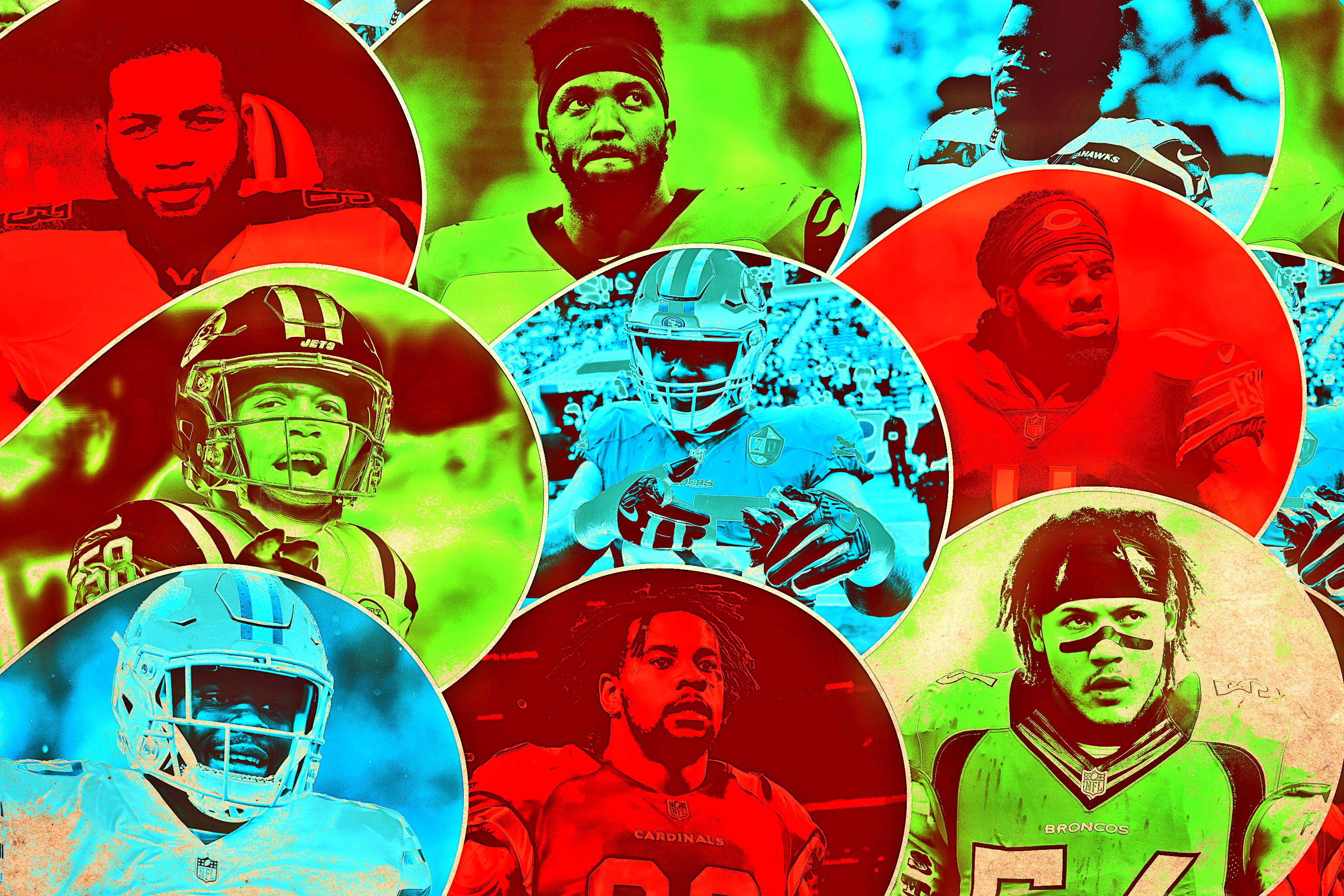
Early-round picks are typically afforded more opportunities and a whole lot more patience than some of their late-round or undrafted brethren—but for both, there’s a limit. Bills third-year pass rusher Shaq Lawson was made aware of that in a public way last week when GM Brandon Beane told The Athletic, bluntly, that Lawson “hasn’t lived up” to expectations. The message was clear: The former Clemson star—who was chosen 19th overall by the previous regime, has registered just 6.0 sacks in two seasons, and was the recent subject of trade rumors—is finally facing what might be his last shot to prove himself with the team that drafted him.
Lawson’s not alone as a former top pick facing a make-or-break year. He’s joined by a handful of former first- and second-rounders who have, thus far, struggled to live up to their draft billing. For each of these nine players, the 2018 season represents the final opportunity to post a breakout performance—and avoid earning that dreaded “bust” label.
DT Robert Nkemdiche, Cardinals
Sometimes, change is good. The Cardinals are hoping that’s true for Nkemdiche, who has failed to notch a sack in 17 career games.
Arizona’s not likely to completely shift away from their old 3-4 blitz-heavy system, but they should employ plenty of the one-gap concepts that new head coach Steve Wilks and defensive coordinator Al Holcomb ran with the Panthers last year—a move that could pay dividends for Nkemdiche, an athletic and aggressive penetrator. Alongside pass rushers Chandler Jones and Markus Golden, Nkemdiche could see an uptick in one-on-one pass-rushing opportunities and has what looks to be a great chance to finally turn into the type of interior disruptor the team envisioned when they made him the 29th overall pick of the 2016 draft.
Nkemdiche will have to adapt to that new scheme, and he’ll have to prove that his maturity issues, which irked former coach Bruce Arians early on, are behind him. The 6-foot-4, 296-pound defensive lineman, who ran a combine 40 time of 4.87 seconds and jumped 35 inches in the vertical, is tailor-made to play the role of an attacking 3-technique in a 4-3 front. The Cardinals’ shift to a more Carolina-styled defense, along with a little better luck in the injury department (Nkemdiche was slowed by a calf injury last year), could be just the change Nkemdiche needs for a breakout campaign.
G Joshua Garnett, 49ers
The 49ers’ decision to sign guard (and former Lions draft bust) Laken Tomlinson to a three-year, $18 million contract extension last week solidified him as the team’s starter at left guard—and also shined some light on the uncertain future of Garnett, another former first-round pick who, according to The Sacramento Bee, is in danger of getting cut. Garnett was a selection of former GM Trent Baalke and head coach Chip Kelly, after all (28th overall in 2016), and never seemed to be a logical fit for new coach Kyle Shanahan’s zone-blocking scheme, which favors athleticism and quick feet over raw strength and bulk. It didn’t help, either, that he lost all of last season to a knee injury.
But Garnett didn’t waste the time he spent on injured reserve. He reportedly lost 25 pounds since last season, and a possible boost in both speed and agility could put him in a position to compete with veterans Jonathan Cooper and Michael Person for the starting right-guard job. If Garnett can emerge as a reliable starter at that spot, it’d be a major boon for Shanahan and the 49ers offensive line, which is now tasked with protecting big-money quarterback Jimmy Garoppolo.
OLB Kevin Dodd, Titans
It’s been a rough first couple of years for Dodd, who’s produced just one sack in 18 career games. The former Clemson star missed nearly half of his rookie season due to a stress fracture in his foot and wasn’t utilized much as a sophomore, playing just 92 snaps. Year 3 is likely Dodd’s last shot with the Titans, and his chances hinge on how well he takes to the team’s new scheme under head coach Mike Vrabel and defensive coordinator Dean Pees.
The good news for Dodd is that Tennessee is light on depth behind starting outside linebackers Brian Orakpo and Derrick Morgan, both of whom are entering contract years. And Dodd, at 6-foot-5 and 277 pounds, may benefit from the versatility to bump inside and rush from the interior in passing-down situations. But while Vrabel noted that turning a college defensive end into a pro outside linebacker is “not a transition that happens overnight,” Dodd may have to speed his development up to have a future in Tennessee. In the meantime, he’ll have to compete for snaps with Josh Carraway, promising rookie second-rounder Harold Landry, and third-year pro Aaron Wallace, who missed all but two games last season due to a back injury.
T Cedric Ogbuehi, Bengals
Ogbuehi finished last year ranked 50th out of 55 qualifying tackles in pass-blocking efficiency, per Pro Football Focus, surrendering eight sacks (tied for fourth most), four quarterback hits, and 23 hurries. And if that wasn’t proof enough that Ogbuehi’s NFL status is in doubt, the team’s acquisition of Cordy Glenn over the offseason confirmed that the team doesn’t think Ogbuehi is its long-term answer at left tackle.
That means the 21st overall pick of the 2015 draft must save his Bengals career on the other side of the line, competing with interior linemen like Christian Westerman, Alex Redmond, and Trey Hopkins for the starting right-guard spot, or with Jake Fisher and Bobby Hart at right tackle. It’s anything but a given that Ogbuehi will win the starting role for either position—but reports out of OTAs indicate that he’s making big strides under new OL coach Frank Pollack, and he emerged as a surprise candidate for the right-tackle spot.
OT Germain Ifedi, Seahawks
Ifedi’s subpar play was one of the main culprits behind the Seahawks’ struggles on their offensive line last year. The 31st overall pick of the 2016 draft allowed 45 hurries (fourth-most at his position) after making the move from right guard to right tackle, and gave up four sacks and three quarterback hits while leading the NFL in accepted penalties (16). Still, heading into 2018, he’s on track to return as the team’s starter at that spot.
An updated scheme under new offensive coordinator Brian Schottenheimer and offensive line coach Mike Solari (which should incorporate a heavier dose of power runs) could help. And another offseason learning the nuances of the right-tackle spot certainly can’t hurt. But unless Ifedi improves in his pass-blocking technique and reins in his penchant for false starts and holding penalties, it’s hard to see the Seahawks sticking with him much longer.
WR Kevin White, Bears
White just has to stay healthy. The seventh overall pick of the 2015 draft has missed 43 of 48 possible games for the Bears over the past three years due to a long line of shin, leg, ankle, and shoulder injuries, and as a result, has logged just 21 career receptions for 193 yards.
But 2018 is, more or less, a blank slate for the former Mountaineers playmaker. He’ll be playing under a new head coach in Matt Nagy, who’s implementing a new system with a bevy of new players, all of whom will be vying for presently unclaimed roles. And per ESPN reporter Jeff Dickerson, White was the team’s surprise offseason standout, and “looked better than expected running routes in [Nagy’s] West Coast offense.“
White should enter training camp behind big-ticket free agent Allen Robinson, veteran newcomer Taylor Gabriel, and second-round rookie Anthony Miller on the team’s receiver pecking order, but outside of that trio, there’s few sure contributors. If White can stay healthy, recapture some of that 4.35 40 speed he showed off at the combine, and carve out a role for himself in Nagy’s passing attack, he could be in for a late-breakout year.
WR Breshad Perriman, Ravens
Perriman was one of the stars of the Ravens’ offseason OTAs last year—“haul[ing] in deep throws nearly every practice” while “showing off his unique speed and big-play ability”—but then struggled mightily when the real games began, reeling in just 10 catches on 31 targets while racking up a 28.6 percent drop rate (tied for ninth-worst among wide receivers, per PFF) before getting benched midway through the season. This offseason, Perriman has reportedly struggled with drops and failed to stand out at the team’s minicamps and OTAs.
Like White, Perriman’s jockeying for position among a brand-new group of receivers, with newcomers Michael Crabtree, Willie Snead, and John Brown favorites for major roles. But those changes create uncertainty, and if Perriman can stay healthy and cut down on the drops that plagued him last year, he’s got a shot to become a surprise contributor for the Ravens in 2018.
T Ereck Flowers, Giants
The past year has been nothing short of a disaster for the former ninth overall pick: Flowers graded out 42nd among 55 qualifying tackles in 2017, per Pro Football Focus, credited with allowing six sacks, eight QB hits, and 27 hurries, and he was benched for the team’s meaningless Week 17 game after reportedly being “checked out” at practice. He was subsequently and unsurprisingly the subject of offseason trade rumors, and after the team’s new brass replaced him at the left-tackle spot with free agent Nate Solder, he initially didn’t show up for offseason workouts.
But after hiring a new agent, Flowers changed course and showed up for the rest of the team’s OTAs, and he’s leaned into his new job at right tackle, taking every first-team rep in media-attended practices. He’s even drawn praise from new head coach Pat Shurmur, who noted Flowers has “done a really good job. He’s an excellent athlete and he’s handling the move pretty seamlessly.” Flowers has started all 46 of his career games at left tackle, but a move to the right, while challenging, could be just what it takes for him to save his career.
LB Shane Ray, Broncos
If Von Miller and rookie Bradley Chubb are like “Batman and Robin,” as Broncos defensive coordinator Joe Woods recently put it, what’s that make Ray? For now, he’s the forgotten man: After three years in the league, Ray’s failed to emerge as the dominant pass rusher the team envisioned pairing with Miller when they chose him with the 23rd pick of the 2015 draft, and now he’s expected to miss the start of the season after having surgery on his wrist—his fourth in the past year. That setback along with the injury-shortened 2017 campaign in which he grabbed just one sack in eight games puts Ray in a precarious position with the team: He’s already almost surely fallen behind Chubb on the depth chart, and when he does return from injury, he may see plenty of competition from Shaquil Barrett and rookie Jeff Holland.

